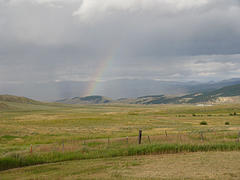A Land Trust of Landowners for Landowners
By: Amos S. Eno
Posted on:07/14/2010 Updated:08/21/2012The Colorado Cattlemen’s Agricultural Land Trust: making best use of a tax credit and lottery funds.
For quite  some time, the folks in Colorado have been voting with their pocketbooks to keep working lands working. At PLN, we’ve been highlighting federal tax incentives for private land conservation since 2000. But the state of Colorado has been making use of two additional incentives.
some time, the folks in Colorado have been voting with their pocketbooks to keep working lands working. At PLN, we’ve been highlighting federal tax incentives for private land conservation since 2000. But the state of Colorado has been making use of two additional incentives.
In 1992, a Colorado citizen’s initiative put a portion of lottery funds into Great Outdoors Colorado, or GOCO, for open space conservation. Since 1994, GOCO has distributed approximately $690 million for more than 3,000 projects throughout the state, many for private land easements.
Next, in 2000, the state of Colorado instituted a tax credit for the donated component of a conservation easement. Since that time, Colorado Cattlemen’s Agricultural Land Trust, or CCALT, has been helping private landowners take advantage of this tax provision. CCALT is one of my favorite organizations, because they are effective, ranking as one of the top easement holders in the country, and they’re innovative.
They are not just a land trust that protects ranches. They also know how to think like, and help, ranchers. As Chris West, their Executive Director, likes to say, “The key thing that sets us apart is we have a dual focus not only on the land but the human resources that go along with it. You don’t have a ranch without a rancher.”
Transferable Tax Credits: Charitable Action Comes Full Circle
CCALT was instrumental in helping to get the innovative transferable tax credit statute passed in 2000 in Colorado - one of only a handful of states to do so. A conservation easement deduction is very little help to an agricultural landowner with little income or losses carried forward. A tax credit provides a way for him or her to get some cash out of the selfless decision to forego the bonus that comes with development.
Chris West explained it to me this way: A landowner with low tax income liability can “transfer” or sell the tax credit to someone with a large tax liability. The guidelines for tax credits piggyback on the original federal legislation governing easement donations, allowing a credit for up to 50% of the value of the donated land value. The landowner can then sell the credit for about 80 cents on the dollar. In this way, everyone wins: the taxpayer purchasing the credit pays less in taxes, the landowner selling the credit gets cash in return for the property donation, and the state of Colorado gets valuable private land protected.
Here’s an example:
-
A farmer or rancher decides to make a “bargain sale” of a conservation easement worth $500,000 in total.
-
He or she gets paid only $200,000 cash for the easement (from a source such as GOCO); the remaining value of $300,000 is the donation.
-
The tax credit value for the donation is 50% of the donation, or $150,000.
-
The farmer or rancher can then sell the credit at about 80% value to a businessman who has liability for state taxes in Colorado, for about $120,000 in cash.
-
This way the businessman gets a discounted tax rate, the farmer or rancher receives $120,000 in cash for the donation, and the state safeguards open space, wildlife habitat and scenic views on protected lands.
-
The tax credit does not begin to equal the development rights on the land, but for a landowner who wants to keep his or her working land working, it can be a good deal, and a viable financial alternative to selling for development.
The Payoff for Working with Farmers and Ranchers
CCALT, which is the only Colorado land trust that serves farmers and ranchers exclusively, got off the ground with the help of grants from the National Fish and Wildlife Foundation, and in 1999 I was invited to keynote their annual board meeting. It was then that I met a Denver attorney named Elizabeth Paris with whom I would later work to organize the first Senate hearing on capital gains tax deductions for conservation easements in 2001.
I have made it a point to stay in touch with CCALT, and just as they were an early impetus for the Resources First Foundation to focus on private lands, they continue to inspire me. For their 15-year anniversary this year, they will celebrate the permanent protection of 350,000 acres - an area larger than the entire Colorado state park system. CCALT’s focus on serving ranchers and farmers has paid off, and it will do so for the entire country provided we can keep our collective eye on the prize of a working landscape.
made it a point to stay in touch with CCALT, and just as they were an early impetus for the Resources First Foundation to focus on private lands, they continue to inspire me. For their 15-year anniversary this year, they will celebrate the permanent protection of 350,000 acres - an area larger than the entire Colorado state park system. CCALT’s focus on serving ranchers and farmers has paid off, and it will do so for the entire country provided we can keep our collective eye on the prize of a working landscape.
 Sign In
Sign In
 Sign In
Sign In
